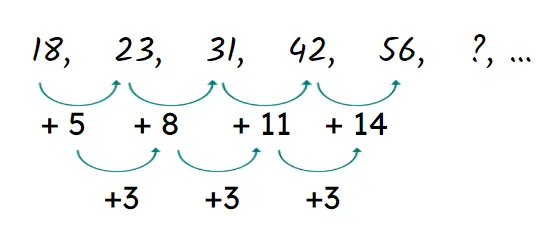Myths about teaching can hold you back


- Year 9


- Year 9
Recognising special number sequences
I can recognise a special number sequence.
These resources will be removed by end of Summer Term 2025.
Switch to our new teaching resources now - designed by teachers and leading subject experts, and tested in classrooms.
These resources were created for remote use during the pandemic and are not designed for classroom teaching.
Lesson details
Key learning points
- You can identify an arithmetic sequence by checking for a common difference between terms.
- You can identify a geometric sequence by checking for a common ratio between terms.
- You can identify a special number sequence if you can identify how to generate the sequence.
Keywords
Arithmetic/linear sequence - An arithmetic (or linear) sequence is a sequence where the difference between successive terms is constant.
Geometric sequence - A geometric sequence is a sequence with a constant multiplicative relationship between successive terms.
Triangular - A triangular number is a number that can be represented by a pattern of dots arranged into an equilateral triangle. The term number is the number of dots in a side of the triangle
Common misconception
After becoming very familiar with arithmetic sequences pupils can find the difference between the first two terms and just assume the sequence is arithmetic.
Explore a large number of geometric and arithmetic sequences and see if pupils can articulate how they check if a sequence is geometric. They might say the terms of the sequence grow more quickly (for some geometric sequences).
To help you plan your year 9 maths lesson on: Recognising special number sequences, download all teaching resources for free and adapt to suit your pupils' needs...
To help you plan your year 9 maths lesson on: Recognising special number sequences, download all teaching resources for free and adapt to suit your pupils' needs.
The starter quiz will activate and check your pupils' prior knowledge, with versions available both with and without answers in PDF format.
We use learning cycles to break down learning into key concepts or ideas linked to the learning outcome. Each learning cycle features explanations with checks for understanding and practice tasks with feedback. All of this is found in our slide decks, ready for you to download and edit. The practice tasks are also available as printable worksheets and some lessons have additional materials with extra material you might need for teaching the lesson.
The assessment exit quiz will test your pupils' understanding of the key learning points.
Our video is a tool for planning, showing how other teachers might teach the lesson, offering helpful tips, modelled explanations and inspiration for your own delivery in the classroom. Plus, you can set it as homework or revision for pupils and keep their learning on track by sharing an online pupil version of this lesson.
Explore more key stage 3 maths lessons from the Non-linear relationships unit, dive into the full secondary maths curriculum, or learn more about lesson planning.

Licence
Prior knowledge starter quiz
6 Questions
Q1.Which of these could be the first four terms in an arithmetic sequence?
Q2. 6, 30, 150, 750, ... are the first four terms in a geometric sequence with common ratio .
Q3.36, 49, 64, 81, ... are the first four terms in a sequence of square numbers. The next term is .
Q4.Which of these are triangular numbers?
Q5.Select the expression that represents 4 more than $$a + 4$$.
Q6.Which of these could be the first four terms in a geometric sequence?
Assessment exit quiz
6 Questions
Q1.The next term in the sequence 8, 2, 10, 12, ... is found by adding the two previous terms. The next term is .
Q2.Which of these could be an arithmetic sequence?
Q3.Which of these could be a geometric sequence?
Q4.Match the first four terms of each sequence with the rule which could describe it.
$$a , 2a, 4a, 8a, ...$$ -
geometric sequence with common ratio 2
$$a , 2a, 4a, 7a, ...$$ -
sequence which starts by adding $$a$$ with second difference $$+a$$
$$2a, 4a, 6a, 8a, ...$$ -
linear sequence with common difference $$2a$$
$$3a, 3a^2, 3a^3,$$$$3a^4, ...$$ -
geometric sequence with common ratio $$a$$
$$a+1, 2a+2,$$$$3a + 3, 4a + 4, ...$$ -
linear sequence with common difference $$a + 1$$
Q5.This sequence starts by adding 5 and has a common second difference of 3. The next term in the sequence is .


